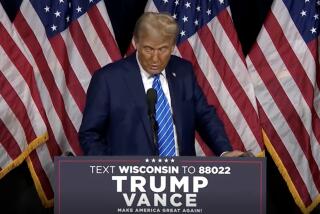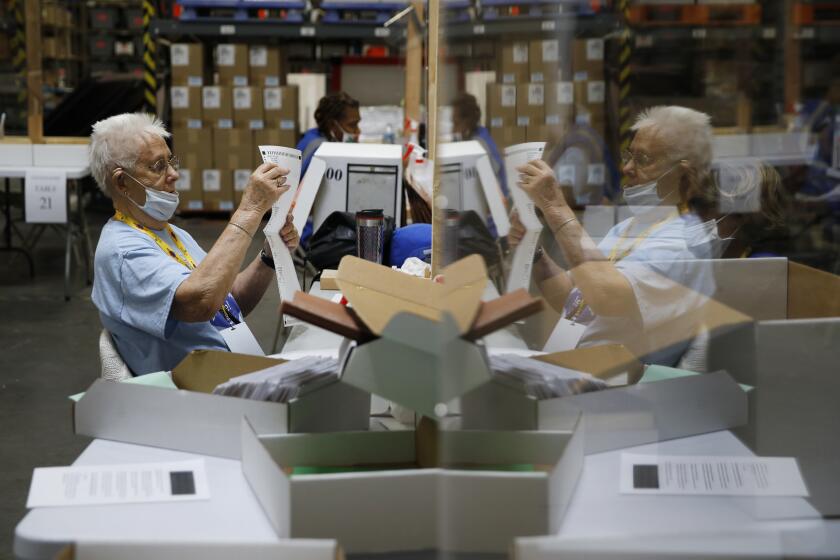Obamacare sign-ups quicken as final enrollment deadline approaches in many states
- Share via
Reporting from Washington — Millions of Americans are signing up for 2018 coverage through the Affordable Care Act, defying the Trump administration’s hostility to the law and a year-long campaign by congressional Republicans to repeal it.
As a final enrollment deadline approaches Friday for consumers in 39 states, sign-ups appear likely to fall short of the 2017 total, due in part to a truncated sign-up period this year. Enrollment will continue into January in several large states, including California and New York.
But the 2018 enrollment period — the first run by the Trump administration — has nevertheless defied expectations and the predictions of the president, who repeatedly proclaimed the insurance marketplaces dead.
“The administration has done what it can to limit sign-ups,” said Sandy Praeger, a Republican who served for 12 years as Kansas insurance commissioner and was president of the National Assn. of Insurance Commissioners.
“But the marketplaces are still around. … I think that demonstrates that people need good health coverage, and these markets have been able to provide it.”
As of last week, nearly 4.7 million people had signed up for a 2018 health plan through HealthCare.gov, the online federal insurance marketplace that serves consumers in 39 states.
Several million more are estimated to have signed up through marketplaces in 11 other states and the District of Columbia.
The pace of enrollment has actually been quicker this year than last, according to federal data. And enrollment by new customers is up nearly 17%.
At the same time, many current HealthCare.gov customers who have not signed up for a new plan for 2018 will be automatically reenrolled.
But because the 2018 enrollment period is only six weeks, compared to three months in previous years, total sign-ups are expected to fall short of the 2017 mark, which topped 9 million on HealthCare.gov. Total 2017 sign-ups, including those on state marketplaces such as Covered California, reached 12 million.
The marketplaces — a centerpiece of the law commonly called Obamacare — have primarily served low- and moderate-income Americans who don’t get health benefits through an employer or a government program such as Medicare or Medicaid.
They have been buffeted all year by uncertainty over their future, with insurers raising rates steeply or exiting markets altogether.
That has been particularly tough for consumers who make too much to qualify for federal insurance subsidies through the healthcare law.
The law offers aid to Americans making between 100% and 400% of the federal poverty line, or between $12,060 and $48,240 a year.
Many insurers also concentrated the rate hikes in certain plans. Because of the complex way the law calculates subsidies, that means many consumers will pay less for coverage in 2018.
But consumer advocates and others have struggled to get the word out about enrolling in coverage through the marketplaces as the Trump administration has slashed funding for advertising and outreach, and the president and his administration have derided the marketplaces.
On the eve of the 2018 open enrollment period, which began Nov. 1, Trump declared, “Obamacare is finished. It’s dead. It’s gone.”
And all year, the U.S. Department of Health and Human Services showcased stories of consumers who say they have been hurt by the current law.
It is still unclear whether the department, which runs the marketplace, will allow consumers who have not completed their applications by the midnight deadline Friday to finish enrollment, as the last administration did.
On Wednesday, Democratic lawmakers urged administration officials to offer a grace period to consumers who have not completed their applications before the midnight deadline.
The Trump administration’s posture was a marked departure from the Obama administration, which labored to get people to sign up for coverage.
It also contrasts with how the Trump administration has treated enrollment in Medicare, which officials have publicly touted.
In the face of the current administration’s hostility, consumer groups, health clinics, insurance companies and others have been scrambling to fill in as the Trump administration stepped back.
This week, President Obama urged Americans on Facebook and Twitter to sign up for coverage and rallied advocates on a nationwide conference call.
“Sadly, we’ve had Republicans in Washington doing their best to try to sabotage the progress that’s been made and to discourage, in many cases, people from signing up,” Obama said. “The good news is … the record numbers of people who’ve signed up so far this year prove how important health insurance is to so many people.”
Officials in several states that run their own marketplaces, including California, have also been aggressively advertising and reaching out to consumers.
Covered California’s enrollment deadline is not until the end of January.
ALSO
Obamacare is helping patients get to the doctor and pay their medical bills, new report finds
Families of patients fear GOP tax plan will slash drug development for rare diseases
Jonah Goldberg: Will tax reform be the GOP’s Obamacare?
More to Read
Get the L.A. Times Politics newsletter
Deeply reported insights into legislation, politics and policy from Sacramento, Washington and beyond. In your inbox twice per week.
You may occasionally receive promotional content from the Los Angeles Times.











